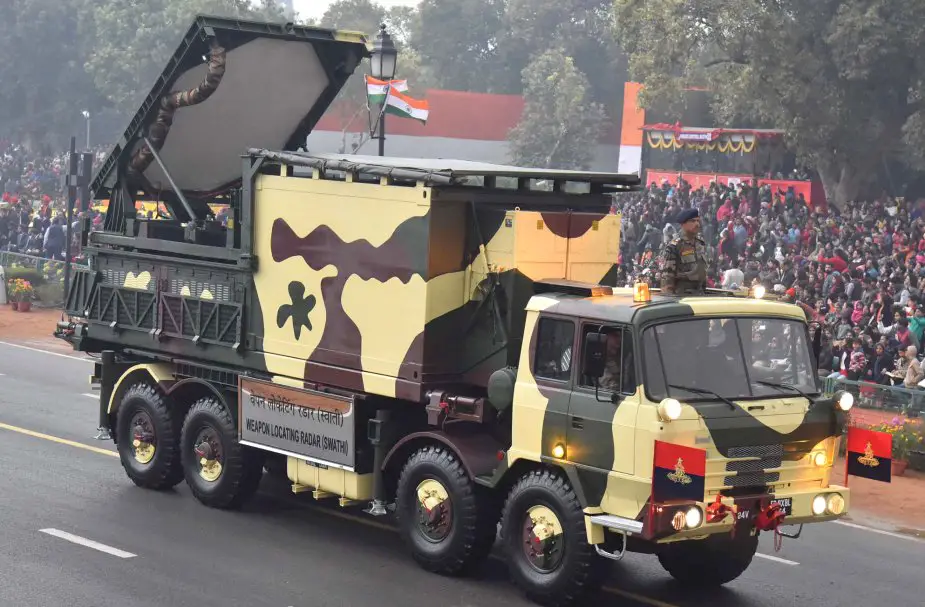As Indian media reported citing sources from the government of India, Armenia has signed a contract worth about $40 million to purchase four Indian ground-based mobile Swathi Weapon Locating Radar (WLR) stations for its artillery. India's Swathi Weapon Locating Radar (WLR) was selected by Armenia as a result of a tender, which involved similar radars of Russian and Polish manufacture. Their shipment is being carried on.

Swathi Weapon Locating Radar (WLR): Indian land-based radar detection mobile station parading at the Republic Day military parade in New Delhi, 25 January 2017 (Picture source: Government of India)
The Swathi Weapon Locating Radar (WLR) is a mobile artillery-locating phased array radar developed by India. This counter-battery radar is designed to detect and track incoming artillery and rocket fire to determine the point of origin for counter-battery fire. The WLR has been jointly developed by Electronics and Radar Development Establishment (LRDE), a lab of Defence Research and Development Organisation (DRDO) and Bharat Electronics Limited (BEL). The sub-systems have been fabricated by BEL based on the DRDO designs and delivered to LRDE for integration.
The detection range for large-caliber artillery rounds is up to 30 km, and increases to 40 km for unguided rockets. The robust design of the radar array and algorithms allows the WLR to effectively operate even in a high-density fire environment, in severe clutter and interference (jamming) conditions. Up to 7 targets can be tracked simultaneously. The radar can track rounds fired at both low and high angles, and at all aspect angles - from behind or towards the radar, or at an oblique angle to the array. The WLR features adaptive radar resource scheduling to increase efficiency and reliability.
At a given position, the radar can scan for targets in one quadrant, encompassing a 90° sector. The array can electronically scan up to +/-45° from its mean bearing. Additionally, for 360° coverage from a given position, the whole array can be rotated by 135° on either side within 30 seconds to quickly change the scanning sector in response to threats.
Upon detecting an incoming round, the automatically acquires and classifies the threat and initiates a track sequence, while continuing to search for new targets. The incoming round's trajectory is tracked, and a computer program analyses the track data and then extrapolates the round's point of origin. This calculated point of origin is then reported to the radar operator, thus allowing friendly artillery to direct counter-battery fire towards the enemy artillery.
The WLR also allows for remote operation and data-linking for better situational awareness at higher echelons of the command hierarchy. The data can be automatically transmitted to a command center and can communicate with higher echelons. The radar data can also be displayed on a remote screen to protect operators from any targeted attacks on the radar. The operators can also remotely change the scanning sector. Many radars can be networked together to work in tandem and increase accuracy and provide more information.
The WLR is configured on an 8x8 Tatra truck platform. The trucks are manufactured by BEML in India under license. The WLR is designed to operate in a high-density fire environment and has all-weather capability, high mobility and quick reaction time. The system is a two-vehicle configuration, with the primary sensor, processors, displays and control unit on a single vehicle, and a separate power vehicle to power the radar. The radar data can also be displayed remotely.
The Radar is designed to operate in harsh environments ranging from -20 to +55°C, in hot and humid conditions, and can be safely stored from -40 to +70°C. It can operate at high altitudes up to 16,000 feet (4,900 m).[1][2] Shock & vibration performance and resistance to EMI/EMC are according to international military standards. The WLR is designed for quick deployment and decamp, and can be ready for action within 30 minutes. In case of any incoming threats, the radar can be quickly moved out of the threat area.
Swathi WLR has been tested and proven by DRDO since 2003, but it was not until March 2017 that the first of 28 ordered series systems were handed over to the Indian Army. Armenia becomes the first known foreign customer for Swathi radars.














